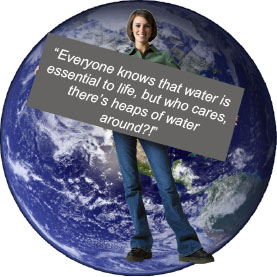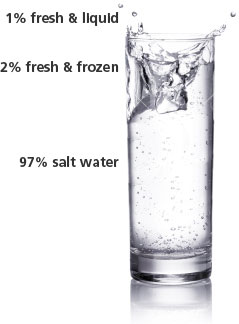Local Overview

Welcome to the first of six online interactive modules aimed at helping you understand where the water you use every day comes from, how it is used, and where it goes. Along this journey you'll get to meet students from 15 other schools , located in Australia and the United States of America, and see how water works in their area. By reviewing how things work elsewhere, you'll be equipped to make recommendations on how you think water can be managed more sustainably in your local region.
Before we get started on some exercises, let's talk a bit about water. Water is pretty important for all of us. Did you know that water is essential to life on our planet and that without it nothing could survive?
 Yes there is a lot of water around. In fact two-thirds of our planet is covered by water, but only 3% of all the water on the planet is fresh water, the remaining 97% is salty ocean water that is toxic to humans, plants and animals living on land.
Yes there is a lot of water around. In fact two-thirds of our planet is covered by water, but only 3% of all the water on the planet is fresh water, the remaining 97% is salty ocean water that is toxic to humans, plants and animals living on land.
Of the 3% that is fresh water, 2% is frozen in icecaps and glaciers! That leaves us with only 1% of all the water on Earth suitable for our existence! Considering about two-thirds of your body is made up of water, this makes this 1% pretty important.
What is troubling is that the earth has a limited amount of water. Run and get a glass of water and put it on the table next to you. Take a good long look at the water. Now, can you guess how old it is?
It is really really really old! It has been around pretty much as long as the earth has. That glass of water may have been drunk by dinosaurs, Egyptian pharaohs, Albert Einstein and perhaps even you before! And you thought your teacher was old!
What does evaporation, transpiration, condensation, precipitation and collection mean?
Water keeps going around and around and around in what we call the "Water Cycle". It's likely that it has travelled round the world multiple times as a gas, a liquid and as a solid. This natural cycle is made up of a few main parts:
- evaporation (and transpiration)
- condensation
- precipitation
- collection
How much water do you suppose is contained in 7,000,000,000 human beings?
With the human population surpassing 7 billion people, the amount of fresh water water available to us is quickly becoming harder and harder to get. Us clever humans, however, are finding more and more ways to get fresh water, though these ways typically use a lot of electricity, cost a lot of money and add more stress on the environment. We have in fact, significantly modified the natural water cycle to deliver water to our homes, schools, and industry so that our taps don't run dry, the toilets keep flushing and our lawns stay green. This modified water cycle is referred to as the urban water cycle and is represented by the following steps outlined in the below figure.
Understanding this urban water cycle is the journey we will be taking over the coming months though interactive online modules. You'll be required to contact your local government for information, hopefully organize a tour of some of your local water facilities, search the internet for information and most importantly have some fun!
Before you proceed to the module questions, check out this videos explaining the natural water cycles in the USA and Australia.
What do you think are the key difference between the US and Australian water cycles?
Module 1 Instructions
Before you get started on your urban water cycle, we want you to tell us about your school and provide some facts about where you live. This will provide the context for how and why urban water cycles vary from place to place.
Good luck and we can't wait to hear from you!!!
Post Comment
To leave a comment, you must be signed in








